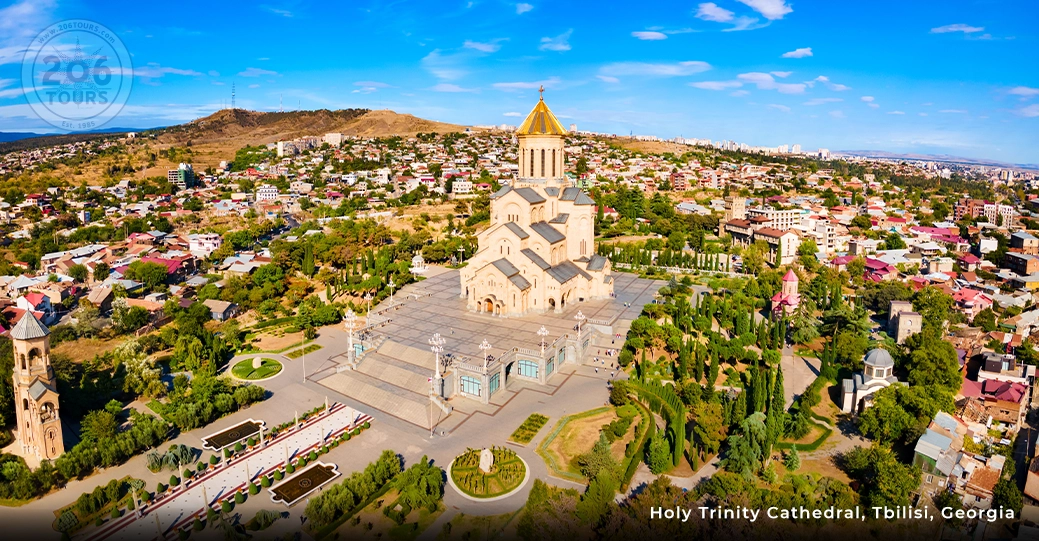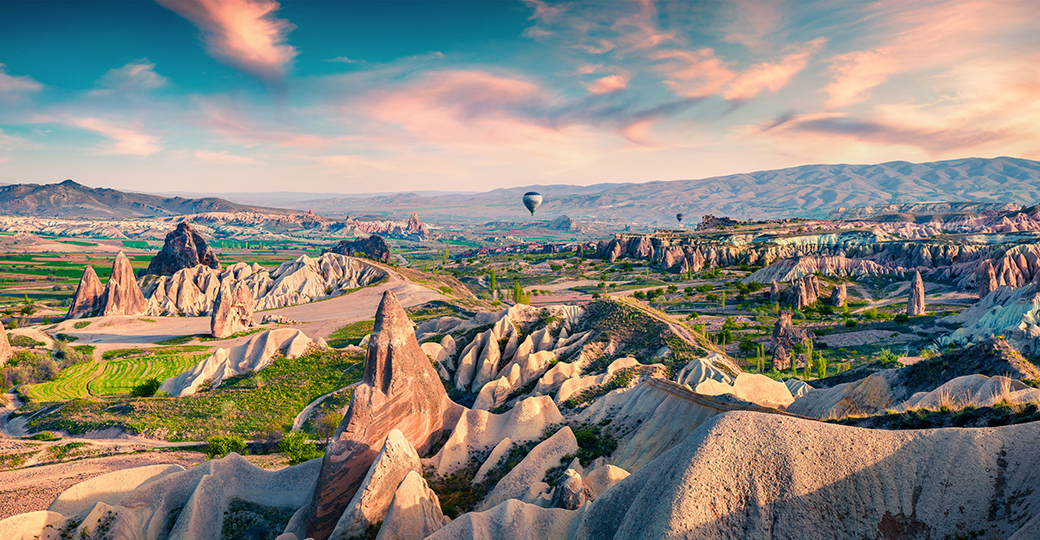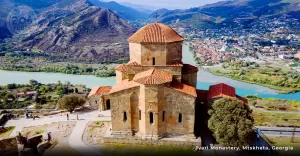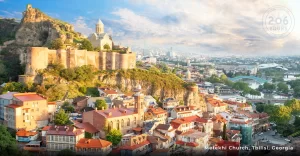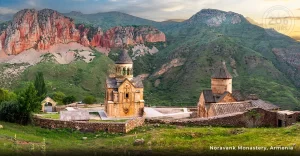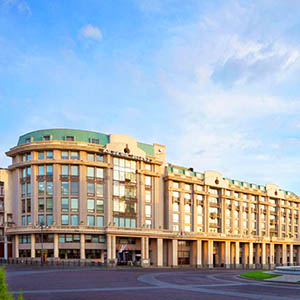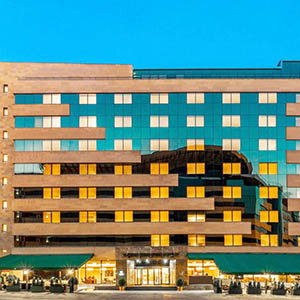Your trip includes
-
Round trip airfare from Chicago (ORD)
- Airport Taxes and Fuel Surcharges
- Hotel accommodations: (or similar) in double occupancy
- ~ 2 nights: Jun 17 - 19: Arts Hotel Taksim, Istanbul, Turkey
- ~ 2 nights: Jun 19 - 21: Ramada By Wyndham Cappadocia, Cappadocia, Turkey
- ~ 1 night: Jun 21 - 22: Adempira Termal & Spa Hotel, Pamukkale, Turkey
- ~ 3 nights: Jun 22 - 25: DoubleTree by Hilton Izmir – Alsancak, Izmir, Turkey
- ~ 3 nights: Jun 25 - 28: Courtyard by Marriott Tbilisi, Tbilisi, Georgia
- ~ 1 night: Jun 28 - 29: Best Western Plus Paradise Hotel Dilijan, Dilijan, Armenia
- ~ 3 nights: Jun 29 - Jul 2: Yerevan Place or Opera Suite Hotel, Yerevan, Armenia
- Breakfast daily, One lunch and 14 dinners
- Wine and mineral water with dinners
- Transfers as per itinerary
- Transportation by air-conditioned motor coach
- Whisper headsets
- Assistance of a professional local Guide
- Sightseeing and admissions fees as per itinerary
- Mass daily & Spiritual activities
- Luggage handling (1 piece per person)
- Flight bag & Digital confirmation of all travel documents
Not Included
- Meals and beverages not mentioned, Tips to your guide & driver.
Itinerary
Day 1 | Monday, June 16: Depart for Turkey
Make your way to your local airport, where you will board your overnight flight(s). Meals will be served on board.
Day 2 | Tuesday, June 17: Arrival in Istanbul
Arrive in İstanbul, the only city in the world that is founded on two continents. Meet with your guide and transfer to the hotel. Dinner at the hotel. Overnight at the hotel in Istanbul.
Day 3 | Wednesday, June 18: Istanbul
Full day sightseeing in Istanbul. Visit the site of one of the biggest Hippodromes in the Roman World for 200.000 people, with Egyptian Obelisk and the Serpent Column. From here proceed to the 17th century Blue Mosque, world famous for the beauty of blue Iznik tiles. Visit the Mosque of St Sophia (6th c. AD), a masterpiece Byzantine Christian Architecture and one of the oldest and biggest cathedrals of the world, now turned into a mosque. Visit Topkapı Palace (harem section is not included), the residence of the Ottoman Sultans from the 15th to the 19th centuries to see the famous Topkapı Dagger and one of the biggest diamonds of the world: The Spoon Maker’s Diamond. At the end of the day visit one of the oldest shopping malls of the world. The Covered Bazaar from 15th century with more than 4000 shops with carpets, jewelry, tiles and souvenirs. Tonight, dinner will be served at local restaurant. Overnight in Istanbul.
Day 4 | Thursday, June 19: Istanbul – Adana – Tarsus – Cappadocia
Early in the morning transfer to the airport for the morning flight to Adana. Upon arrival depart for Tarsus, the birthplace of St. Paul. Visit St. Paul’s well, located in the camii cedid quarter. This is believed to be the place where the house of St. Paul once stood. There is a portrait of St Paul hanging on the wall and some information about his life. the water in the 38-meter-deep well is considered holly and curative. The birth date of the saint is not exactly known, but it is assumed that he was born between 5 and 15 ad. As a native of the city, he once said in his speech to the roman commander in Jerusalem,” I am a Jew, a Tarsian from Cilicia, a citizen of no mean city”. Drive to Cappadocia, an extensive region of odd, conic forms of gray, yellow rock, some topped with off-angle hats, and many more than 15 m high. In Turkish these cones have been poetically called peri bacalari- fairy chimneys. Over 3500 rock churches have been identified in the area. Several symbols appear throughout, pomegranates, birds, lions, snakes, vines, and obvious crosses. There are many underground cities were places of refuge where people have hidden themselves from invaders. Overnight in Cappadocia.
Day 5 | Friday, June 20: Cappadocia
Full day tour of Cappadocia. Cappadocia is a unique site in the world with, fantastic volcanic landscapes, underground cities of early Christians and thousands of rock cut churches with fantastic fresco paintings. Cappodocia is under the protection UNESCO Cultural Department as a unique World Heritage Site. The roots of monastic life go back to Cappadocia. St Basil of Caseria established and encouraged monastic life in Cappadocia which had led to thousands of monastic communities during the medieval times. St Paul travelled on the outskirts of Cappadocia which explains the existence of many churches in Cappadocia. We spend all day exploring the history and scenery of Cappadocia. Firstly, we’ll visit the gently folding volcanic rock formations and “fairy chimneys” of Goreme Open Air Museum. These rock formations are not only beautiful, but functional as well. Many early Christian communities lived and worshipped deep in the rocks and crags, leaving their frescoes and paintings to be marveled at centuries later. Other communities lived underground, and we’ll visit one of the underground cities (kaymakli orsaratli or ozkonak). To protect themselves from Roman persecution and marauding bandits, local people began to live in underground caves forming “cities” that reach a depth of up to 7 stories below the surface. Other sites include the Natural Citadel of Uchisar and the small, picturesque village of Avanos – famous for their red clay pottery. In Avanos we’ll visit “The Potter’s Place: Gift Shoppe and Cultural Centre” and have time for visiting local potter for a demonstration and maybe try your own hand at the potter’s wheel. Dinner at hotel. Overnight in Cappadocia. This morning, you will board the bus and enjoy the scenic route to the Abbey of Monte Cassino, the principal monastery of the Benedictine Order, founded by St. Benedict around 530 A.D. Continue on to San Giovanni Rotondo, where St. Pio of Pietrelcina (St. Padre Pio) lived for many decades and where thousands of people have flocked in order to be closer to this great saint and to Our Lord. Dinner and overnight in San Giovanni Rotondo.
Day 6 | Saturday, June 21: Cappadocia – Psidian Antiochia – Pamukkale
Drive to Psidian Antiochia, a very rich Roman metropolis, by the foot of impressive Taurus mountain range It was here, in Pisidian Antioch where Apostle Paul delivered his first recorded sermon in Asia Minor. (Acts 13:16) (Acts 13:44). Visit the synagogue and the churches of the city together with the temple and the theatre. End your day in Pamukkale which means “cotton castle” where you see fantastic dazzling white limestone terraces formed by travertine deposits from hot water springs running over the chalk cliffs. Dinner at hotel. Overnight in Pamukkale.
Day 7 | Sunday, June 22: Pamukkale – Laodicea – Hierapolis – Philadelphia – Sardis – Izmir
After breakfast depart for the sightseeing. Visit to Laodicea which was one of the seven churches of Asia Minor (Rev 3:14-22) where John called the Christians “Lukewarm”. Recent Turkish excavations on the site are revealing the walls of a what might have been a monumental church. Then to Hierapolis where Apostle Philip came to spread the Christianity, and is believed to have lived and martyred here. Hierapolis is mentioned in St. Paul’s epistle to the Colossians (Colossian 4:13). Explore one of the richest cemetery grounds of the ancient world, the main Domitian Gate and the main avenue. Visit the white travertine cascades of Pamukkale. Pamukkale is a unique site in the world, declared as World Heritage Site by UNESCO Cultural Department. Then drive to ancient Philadelphia to see the remaining walls of a monumental church. Philadelphia together with Symrna was one of the two seven churches of Asia Minor which did not receive any criticism about applications of Christianity. Then continue to to Sardis, the capital city of Lydian Kingdom. Sardis was one of the very rich metropolises of Asia Minor with crowded populations of Jews which might have enabled the Good News to be heard at a faster. The site is presently under the excavation of Harvard and Berkeley Universities. The city was where the richest man on earth, King Croesus enjoyed an incredible power and wealth. Lydians invented and minted the first coins in the world. Visit one of the oldest synagogues of the world which was later converted into a church. Also visit the monumental Artemis Temple and the impressively restored Roman Imperial Hall. Proceed to Izmir, ancient Smyrna, one of the Seven Churches in Revelation. This very important city is hidden under modern Izmir. Check in to your hotel for dinner and overnight.
Day 8 | Monday, June 23: Izmir – Pergamon – Izmir
Begin the day with visiting the archaeological remains of the Agora and drive to Bergama-ancient Pergamon (Rev 2:12-17). Early Christian martyr Antipas was tortured to death here. Pergamon was the site of many temples to pagan Gods. Yet Christianity took a stronghold here as early as 2nd century, attested by the monumental size of Basilica of St. John. We have no evidence about Paul visiting in Pergamon. But it is clear that he walked through the area as he was on his way to Macedonia.Pergamon was the capital city of Hellenistic Kingdom of Pergamon. Pergamenese Library was the second richest library of the ancient world after the library in Alexandriapolis, Egypt. The city of Pergamon was also where parchement paper was invented. Short drive to the hospital site of Pergamon, named as Asklepion. Asklepion was among the three most famed hospitals of the ancient world. Then drive to Thyatira, which is another Seven Churches mentioned in the Book of Revelation. View the ancient roadway and period columns. Dinner at hotel. Overnight in Izmir.
Day 9 | Tuesday, June 24: Izmir – Ephesus – Izmir
Today visit the glorious city of Ephesus (Rev 1:11, 2:1-7) (Acts 18:19-28, 19:1-41 Ephesians). Ephesus was the capital city of Roman Province of Asia Minor; the site of One of the Seven Wonders of the World; Temple of Artemis, and the site of the third richest library of the ancient world; Celsus library. St. Paul came to Ephesus in 54 AD and stayed for three years. He preached the Gospel, gained followers and also established the church of Ephesus. St John (author of Revelations according to the New Testament) also spend his last years in Ephesus. St. John is believed to have been buried within the Basilica of St John. A strong tradition in the Catholic Church claims that St. John brought Virgin Mary to Ephesus and she ascended to heaven from Ephesus. Your visit to Ephesus will include the archaeological site, the Basilica of St John and the House of Virgin Mary. Dinner and overnight in İzmir.
Day 10 | Wednesday, June 25: Izmir – Istanbul – Georgia – Tbilisi
Transfer to the airport for your flight to Georgia via connection in Istanbul. Arrival in Tbilisi. Transfer to the hotel. Have some rest. Today, we will explore the capital of Georgia, Tbilisi. Wander in the old districts of the city which are structured like terraces, as well as take a walk in the narrow streets to enjoy colorful houses, patterned balconies and wonderful samples of modern architecture. We will start the tour from Metekhi church (13th century) facing the magnificent views over old Tbilisi. A stroll along winding little streets takes us to the main sights of the city. Afterwards, we enjoy the panoramic views of the whole town and through the ancient Narikala fortress(4th century), find ourselvesin the historical domed sulphur bath area- connected with the name of our city. Then, we visit the largest cathedral in Caucasus region – Holy Trinity Cathedral, constructed between 1995 and 2004 with a mixture of the old and modern architecture. Dinner at a local restaurant. Overnight in Tbilisi.
Day 11 | Thursday, June 26: Tbilisi – Mtskheta – Tbilisi
Breakfast at the hotel. In the morning, visit the ancient capital and religious centre of Georgia – Mtskheta and its historical sights: Jvari Monastery (6th century) and Svetitskhoveli Cathedral (11th century) – both UNESCO World Heritage sites. Later, visit Samtavro nunnery. Then, we will drive to visit Shiomgvime, where one of the assyrian father (Shio)spent his years as hermit. Afterwards, return to Tbilisi. Dinner at a local restaurant. Overnight in Tbilisi.
Day 12 | Friday, June 27: Tbilisi – Sadakhlo(border) – Haghpat – Sanahin – Dilijan
After breakfast drive to Georgia-Armenia border. Check point Sadakhlo. Continue trip to Armenia. Visit Haghpat Monastery, also known as Haghpatavank, a medieval monastery complex in Haghpat, Armenia, built between the 10th and 13th century. Pay a visit to the monastery of Sanahin, which is listed as a World Cultural Heritage Site by UNESCO. The architectural complex widely considered to one of the most outstanding works of medieval Armenian architecture. Take a trip up north to the spectacular forested region of Dilijan, a resort town known as “Armenian Switzerland”. Dinner at the hotel. Overnight in Dilijan.
Day 13 | Saturday, June 28: Dilijan – Haghartsin – Sevan – Sevanavank – Yerevan
Breakfast at the hotel. After exploring around its time to pay a visit to Haghartsin monastery located high in woods covered mountains with eagles soaring high above the tree line. The oldest building on the complex is St. Gregory the Illuminator’s church. It was built between the 9th and 10th centuries and is also the site of the first musical university of Armenia. Set off to Lake Sevan, the emerald of Armenia and the second largest alpine lake in the world. Admire the picturesque views of one of the highest bodies of water in the worlds. Then visit Sevanavank monastic complex. The monastery of Sevanavank wasfounded in 874 by Princess Mariam, after the artificial draining of Lake Sevan, which started in the era of Joseph Stalin, the water level fell about 20 metres, and the island transformed into a peninsula. Drive to Yerevan. Welcome dinner at a traditional restaurant with folk show. Overnight in Yerevan.
Day 14 | Sunday, June 29: Yerevan city tour – Echmiadzin – Zvartnots – Yerevan
Breakfast at the hotel. We start our tour from the Republic Square, the magnum opus of architect Alexander Tamanian. Continue to Cascade Complex, an open-airmuseum of modern art. The complex linksthe downtown with the residential area with massive stairways leading up to the Victory Park providing a fantastic overlook to the entire downtown from above. The monument to Mother Armenia is standing tall in the park carefully guarding the city from above. Next, we are in the Opera House, a remarkable example of urban architecture and a lively hub of the city. Freedom Square isjust behind it,surrounded by parks and outdoor cafes which are a favorite spot to spend breezy summer evenings. Drive to Echmiadzin Cathedral, one of the oldest standing churches in Christendom and is considered the Mother Church of all Armenia and serves as the cornerstone of Armenian Culture. It was built in 303 AD over It was built over a pagan temple, symbolizing the conversion from paganism to Christianity. According to most scholars it was the first cathedral built in ancient Armenia, and is often considered the oldest cathedral in the world. Then visit the UNESCO Heritage listed remains of Zvartnots Cathedral – the perfect example of the 7th c. Armenian architecture. Grandiose ruins of once magnificent center of Armenian Church overlooking Mount Ararat. We will have lunch at Tasty House with “Dolma” making master class. Our owner Mrs. Zara, is a former TV host, who used to host celebrities to prepare together by Armenian recipes. She’ll share with us Armenian preparation techniques, and secrets around coffee/tea table. Drive back to Yerevan. Overnight in Yerevan.
Day 15 | Monday, June 30: Yerevan – Khor Virap – Areni Cave – Noravank – Yerevan
Breakfast at the hotel. Take a trip to Khor-Virap monastery and indulge yourself in exploring its charming architecture and rich history, both religious and cultural. It is situated in the Ararat valley against the backdrop of biblical Ararat Mountain, where Noah’s Ark cast it’s anchor. The importance of this monastery stems from its connection with Saint Gregory the Illuminator, who introduced Christianity to Armenia thus making Armenia the first Christian nation in the world. Explore the depths of Areni Cave system. It’s history dates back to at the very least 6,000 years ago and its suspected that the cavernoussettlementserved as a trading a cultural hub. Currently its and archeological museum and offers in its exposition ancient items of cultural significance and ancient everyday objects ranging from pieces of clothing to housewares. Continue tour to Noravank monastery – a great religious and cultural center of 12th c. Noravank (“New Monastery”) islocated in a remote location about a hundred km from Yerevan traversing stunning nature and mountainous landscapes. The history of this monastery dates back to the 9th century and contains multiple churches built up over centuries. It’s known for intricate atriums and interior paintings that are sure to impress even the most well-traveled visitor. Back to Yerevan. Dinner at a restaurant. Overnight in Yerevan.
Day 16 | Tuesday, July 1: Yerevan – Garni – Symphony of Stones – Geghard – Choir Performance – Yerevan
Breakfast at the hotel. Proceed to the village of Garni. The citadel and pagan temple of Garni is a picturesque monument of the Hellenistic period and an impressive piece of ancient Armenian architecture. It was built in the first century A.D. by the Armenian King Tiridates and it is dedicated to a heathen god, probably to Mithra, the god of the sun whose figure stood in the depth of the sanctuary. Visit Symphony of Stones. It is said that this natural monument is the result of the collapse of the volcanic rocks. The monument consists of huge paradoxically symmetric hexagon and pentagon basalt columns (nearly 50 meters high). These stones hanging against the gravity resemble an organ, which explains why it is also referred to as “Basalt Organ Pipes”. Visit Geghard monastery inscribed in UNESCO World Heritage list. Geghard is another incredible ancient Armenian monastery, partly carved out of a mountain. The meaning “the Monastery of the Spear”, originates from the spear which had wounded Jesus during his crucifixion, allegedly brought to Armenia by Apostle Thaddeus, and stored amongst many other relics. In Geghard you will have the opportunity to enjoy a choir. A quartet of professional singers sings religious and secular songs. Drive back to Yerevan. Farewell dinner at a restaurant. Overnight in Yerevan.
Day 17 | Wednesday, July 2: Yerevan – Airport – USA
After an early breakfast and heartfelt farewells, your group will leave by motor coach and transfer to the airport for return flights home.
*206 Tours Disclaimer:
Though every effort will be made to follow the itinerary, it should be considered as an indication, rather than a contract of places to be visited. Occasionally local religious holidays, national days, weather, traffic conditions and other events may necessitate changes in the sequence of visits or the missing of certain visits.
Would you like to arrive earlier or stay later?
Let us know at the time of registration if you would like to arrive earlier, or stay later, than the scheduled tour dates, and pending availability, we will change your airline reservations accordingly, additional fees may apply. Pre- and/or post-stays at the hotel will cost an additional fee. These options should be available to you when registering online, or simply contact us: sales@206tours.com








